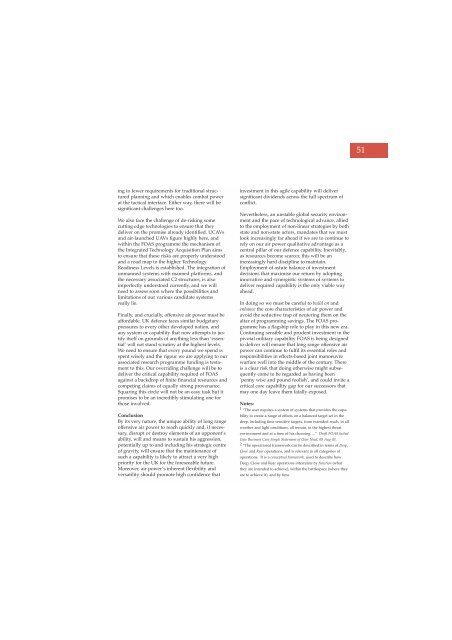Volume 6 No 4 - Royal Air Force Centre for Air Power Studies
Volume 6 No 4 - Royal Air Force Centre for Air Power Studies
Volume 6 No 4 - Royal Air Force Centre for Air Power Studies
Create successful ePaper yourself
Turn your PDF publications into a flip-book with our unique Google optimized e-Paper software.
51<br />
ing to fewer requirements <strong>for</strong> traditional structured<br />
planning and which enables combat power<br />
at the tactical interface. Either way, there will be<br />
significant challenges here too.<br />
We also face the challenge of de-risking some<br />
cutting edge technologies to ensure that they<br />
deliver on the promise already identified. UCAVs<br />
and air-launched UAVs figure highly here, and<br />
within the FOAS programme the mechanism of<br />
the Integrated Technology Acquisition Plan aims<br />
to ensure that these risks are properly understood<br />
and a road map to the higher Technology<br />
Readiness Levels is established. The integration of<br />
unmanned systems with manned plat<strong>for</strong>ms, and<br />
the necessary associated C2 structures, is also<br />
imperfectly understood currently, and we will<br />
need to assess soon where the possibilities and<br />
limitations of our various candidate systems<br />
really lie.<br />
Finally, and crucially, offensive air power must be<br />
af<strong>for</strong>dable. UK defence faces similar budgetary<br />
pressures to every other developed nation, and<br />
any system or capability that now attempts to justify<br />
itself on grounds of anything less than ‘essential’<br />
will not stand scrutiny at the highest levels.<br />
We need to ensure that every pound we spend is<br />
spent wisely and the rigour we are applying to our<br />
associated research programme funding is testament<br />
to this. Our overriding challenge will be to<br />
deliver the critical capability required of FOAS<br />
against a backdrop of finite financial resources and<br />
competing claims of equally strong provenance.<br />
Squaring this circle will not be an easy task but it<br />
promises to be an incredibly stimulating one <strong>for</strong><br />
those involved.<br />
Conclusion<br />
By its very nature, the unique ability of long range<br />
offensive air power to reach quickly and, if necessary,<br />
disrupt or destroy elements of an opponent’s<br />
ability, will and means to sustain his aggression,<br />
potentially up to and including his strategic centre<br />
of gravity, will ensure that the maintenance of<br />
such a capability is likely to attract a very high<br />
priority <strong>for</strong> the UK <strong>for</strong> the <strong>for</strong>eseeable future.<br />
Moreover, air power’s inherent flexibility and<br />
versatility should promote high confidence that<br />
investment in this agile capability will deliver<br />
significant dividends across the full spectrum of<br />
conflict.<br />
Nevertheless, an unstable global security environment<br />
and the pace of technological advance, allied<br />
to the employment of non-linear strategies by both<br />
state and non-state actors, mandates that we must<br />
look increasingly far ahead if we are to continue to<br />
rely on our air power qualitative advantage as a<br />
central pillar of our defence capability. Inevitably,<br />
as resources become scarcer, this will be an<br />
increasingly hard discipline to maintain.<br />
Employment of astute balance of investment<br />
decisions that maximise our return by adopting<br />
innovative and synergistic systems of systems to<br />
deliver required capability is the only viable way<br />
ahead.<br />
In doing so we must be careful to build on and<br />
enhance the core characteristics of air power and<br />
avoid the seductive trap of neutering them on the<br />
altar of programming savings. The FOAS programme<br />
has a flagship role to play in this new era.<br />
Continuing sensible and prudent investment in the<br />
pivotal military capability FOAS is being designed<br />
to deliver will ensure that long range offensive air<br />
power can continue to fulfil its essential roles and<br />
responsibilities in effects-based joint manoeuvre<br />
warfare well into the middle of the century. There<br />
is a clear risk that doing otherwise might subsequently<br />
come to be regarded as having been<br />
‘penny wise and pound foolish’, and could invite a<br />
critical core capability gap <strong>for</strong> our successors that<br />
may one day leave them fatally exposed.<br />
<strong>No</strong>tes:<br />
1 “The user requires a system of systems that provides the capability<br />
to create a range of effects on a balanced target set in the<br />
deep, including time sensitive targets, from extended reach, in all<br />
weather and light conditions, all terrain, in the highest threat<br />
environment and at a time of his choosing….” Draft FOAS Initial<br />
Gate Business Case Single Statement of User Need, 08 Aug 03.<br />
2 “The operational framework can be described in terms of Deep,<br />
Close and Rear operations, and is relevant in all categories of<br />
operations. It is a conceptual framework, used to describe how<br />
Deep, Close and Rear operations interrelate by function (what<br />
they are intended to achieve), within the battlespace (where they<br />
are to achieve it), and by time
















